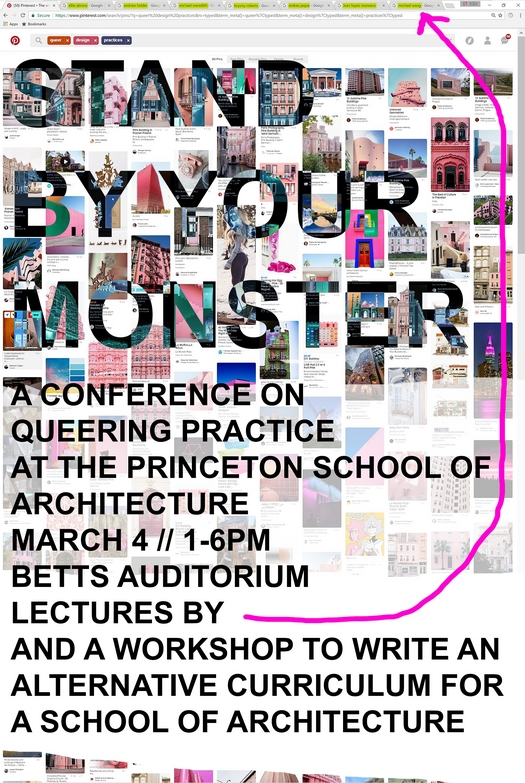Saturday, March 4th
1:00-6:00pm
Betts Auditorium
Guests
Ellie Abrons
EADO; Assistant Professor, University of Michigan Taubman School of Architecture
Andrew Holder
The LADG; Assistant Professor, Harvard University Graduate School of Design
Andres Jaque
Office for Political Innovation; Adjunct Associate Professor at Columbia GSAPP
Michael Meredith
MOS Architects; Assistant Professor, Princeton University School of Architecture
Ivan Lopez Munuera
PhD Candidate, Princeton University School of Architecture
Bryony Roberts
Bryony Roberts Studio, Adjunct Assistant Professor at Columbia GSAPP
Michael Wang
Artist
Organized by Jaffer Kolb
Lecturer, Princeton University School of Architecture
The last five years have ushered in a resurgence of the familiar. Numerous calls among an emerging generation of practitioners have called for a return — framed sometimes as a revitalization of Postmodernism, as a redisciplining of our professional discourse, as the new ancients, and so on. Our current political climate reveals a dark side of nostalgia we shouldn’t lose sight of in our discipline: returning to the tenants of our forefathers without the proper tools of reflection and critique bolsters the type of Eurocentric ideology and hierarchical ontology that perhaps we swung too far away from in the last twenty years. A return to platonic primitivism is all fine as long as we can understand the ways in which our discipline might still carry some mantle of progress.
Fortunately, we already have some methods we might use to condition such a turn. In its many formulations, queerness is relational, strange, and both anti-separatist and anti-assimilationalist. It’s an open mesh of possibilities, gaps, overlaps, dissonances, resonances, lapses and excesses of meaning. In other words: it exists as a counterpoint, a reconfiguring agent. It filters and reprograms and conditions all sorts of subjects.
In this regard we might depart a bit from earlier formulations of queerness in architecture and to understand it as a guide we can use to navigate the past and inflect our methods of design and practice today. Where pioneering work in queer space was more deeply embedded in identity politics, radical forms of breaking normative codes, and spatial choreographies, today we might think more about where queerness might reshape the logic of the discipline and fundamental design methodologies.
Stand by Your Monster looks to a group of designers whose work, consciously or not, demonstrates tactics of queerness borrowed from queer culture, theory, and performance. Such tactics, which include hypersaturation, dysmorphia, playful misquotation, and transgressive materialism among others, are entrenched in the discipline as much as in radical experimentation and carry the mantle of queerness into a new ontology of research and practice.
The conference will begin with presentations by participants who will frame their work as a queer response to a disciplinary topic. These will include: Form, Representation, Surface, Detail, Infrastructure, Order, Character, etc. After, as a group we will consider what it means to design a queer curriculum or develop a queer pedagogy. How can the tactics and projects outlined above reconfigure how we think about teaching architecture? Can we tie a new theory of the discipline into a curricular framework as a more radical act of queering? Following the history of counter-institutional schools, we produce a developable guide for a new kind of education.

